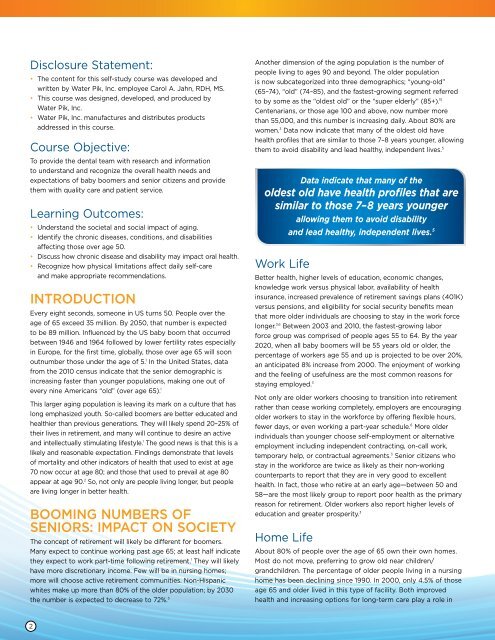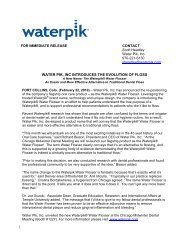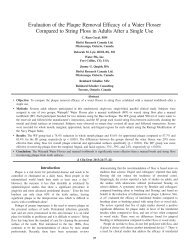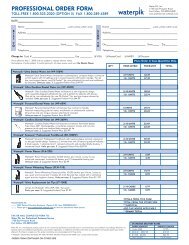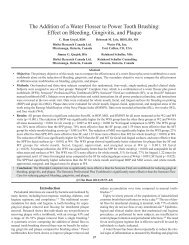Seniors and Boomers: Living Longer, Living Healthier ... - Waterpik
Seniors and Boomers: Living Longer, Living Healthier ... - Waterpik
Seniors and Boomers: Living Longer, Living Healthier ... - Waterpik
You also want an ePaper? Increase the reach of your titles
YUMPU automatically turns print PDFs into web optimized ePapers that Google loves.
Disclosure Statement:<br />
• The content for this self-study course was developed <strong>and</strong><br />
written by Water Pik, Inc. employee Carol A. Jahn, RDH, MS.<br />
• This course was designed, developed, <strong>and</strong> produced by<br />
Water Pik, Inc.<br />
• Water Pik, Inc. manufactures <strong>and</strong> distributes products<br />
addressed in this course.<br />
Course Objective:<br />
To provide the dental team with research <strong>and</strong> information<br />
to underst<strong>and</strong> <strong>and</strong> recognize the overall health needs <strong>and</strong><br />
expectations of baby boomers <strong>and</strong> senior citizens <strong>and</strong> provide<br />
them with quality care <strong>and</strong> patient service.<br />
Learning Outcomes:<br />
• Underst<strong>and</strong> the societal <strong>and</strong> social impact of aging.<br />
• Identify the chronic diseases, conditions, <strong>and</strong> disabilities<br />
affecting those over age 50.<br />
• Discuss how chronic disease <strong>and</strong> disability may impact oral health.<br />
• Recognize how physical limitations affect daily self-care<br />
<strong>and</strong> make appropriate recommendations.<br />
INTRODUCTION<br />
Every eight seconds, someone in US turns 50. People over the<br />
age of 65 exceed 35 million. By 2050, that number is expected<br />
to be 89 million. Influenced by the US baby boom that occurred<br />
between 1946 <strong>and</strong> 1964 followed by lower fertility rates especially<br />
in Europe, for the first time, globally, those over age 65 will soon<br />
outnumber those under the age of 5. 1 In the United States, data<br />
from the 2010 census indicate that the senior demographic is<br />
increasing faster than younger populations, making one out of<br />
every nine Americans “old” (over age 65). 1<br />
This larger aging population is leaving its mark on a culture that has<br />
long emphasized youth. So-called boomers are better educated <strong>and</strong><br />
healthier than previous generations. They will likely spend 20–25% of<br />
their lives in retirement, <strong>and</strong> many will continue to desire an active<br />
<strong>and</strong> intellectually stimulating lifestyle. 1 The good news is that this is a<br />
likely <strong>and</strong> reasonable expectation. Findings demonstrate that levels<br />
of mortality <strong>and</strong> other indicators of health that used to exist at age<br />
70 now occur at age 80; <strong>and</strong> those that used to prevail at age 80<br />
appear at age 90. 2 So, not only are people living longer, but people<br />
are living longer in better health.<br />
BOOMING NUMBERS OF<br />
SENIORS: IMPACT ON SOCIETY<br />
The concept of retirement will likely be different for boomers.<br />
Many expect to continue working past age 65; at least half indicate<br />
they expect to work part-time following retirement. 1 They will likely<br />
have more discretionary income. Few will be in nursing homes;<br />
more will choose active retirement communities. Non-Hispanic<br />
whites make up more than 80% of the older population; by 2030<br />
the number is expected to decrease to 72%. 3<br />
Another dimension of the aging population is the number of<br />
people living to ages 90 <strong>and</strong> beyond. The older population<br />
is now subcategorized into three demographics; “young-old”<br />
(65–74), “old” (74–85), <strong>and</strong> the fastest-growing segment referred<br />
to by some as the “oldest old” or the “super elderly” (85+). 15<br />
Centenarians, or those age 100 <strong>and</strong> above, now number more<br />
than 55,000, <strong>and</strong> this number is increasing daily. About 80% are<br />
women. 3 Data now indicate that many of the oldest old have<br />
health profiles that are similar to those 7–8 years younger, allowing<br />
them to avoid disability <strong>and</strong> lead healthy, independent lives. 5<br />
Data indicate that many of the<br />
oldest old have health profiles that are<br />
similar to those 7–8 years younger<br />
allowing them to avoid disability<br />
Work Life<br />
Better health, higher levels of education, economic changes,<br />
knowledge work versus physical labor, availability of health<br />
insurance, increased prevalence of retirement savings plans (401K)<br />
versus pensions, <strong>and</strong> eligibility for social security benefits mean<br />
that more older individuals are choosing to stay in the work force<br />
longer. 3,6 Between 2003 <strong>and</strong> 2010, the fastest-growing labor<br />
force group was comprised of people ages 55 to 64. By the year<br />
2020, when all baby boomers will be 55 years old or older, the<br />
percentage of workers age 55 <strong>and</strong> up is projected to be over 20%,<br />
an anticipated 8% increase from 2000. The enjoyment of working<br />
<strong>and</strong> the feeling of usefulness are the most common reasons for<br />
staying employed. 3<br />
Not only are older workers choosing to transition into retirement<br />
rather than cease working completely, employers are encouraging<br />
older workers to stay in the workforce by offering flexible hours,<br />
fewer days, or even working a part-year schedule. 6 More older<br />
individuals than younger choose self-employment or alternative<br />
employment including independent contracting, on-call work,<br />
temporary help, or contractual agreements. 3 Senior citizens who<br />
stay in the workforce are twice as likely as their non-working<br />
counterparts to report that they are in very good to excellent<br />
health. In fact, those who retire at an early age—between 50 <strong>and</strong><br />
58—are the most likely group to report poor health as the primary<br />
reason for retirement. Older workers also report higher levels of<br />
education <strong>and</strong> greater prosperity. 3<br />
Home Life<br />
<strong>and</strong> lead healthy, independent lives. 5<br />
About 80% of people over the age of 65 own their own homes.<br />
Most do not move, preferring to grow old near children/<br />
gr<strong>and</strong>children. The percentage of older people living in a nursing<br />
home has been declining since 1990. In 2000, only 4.5% of those<br />
age 65 <strong>and</strong> older lived in this type of facility. Both improved<br />
health <strong>and</strong> increasing options for long-term care play a role in<br />
2


